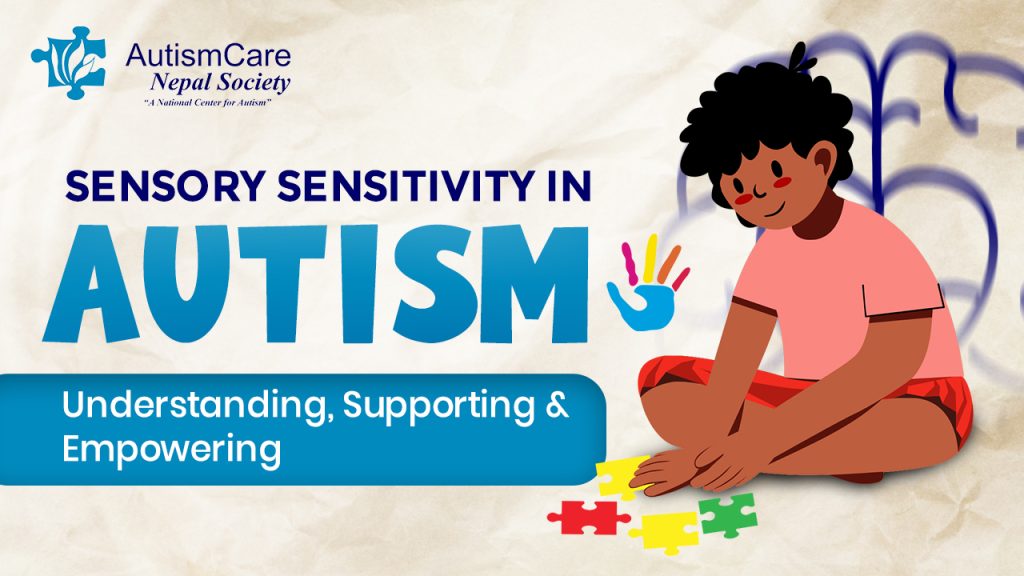Introduction
Sensory sensitivity is one of the most powerful yet often misunderstood aspects of autism. For many individuals on the Autism Spectrum Disorder (ASD) spectrum, everyday sensory input light, sound, smell, taste, texture, movement can become overwhelming or underwhelming. In Nepal, where awareness of sensory processing differences is still developing, recognising and addressing these sensitivities becomes vital to support children, adolescents and adults with autism. This article provides a comprehensive look at sensory sensitivity in autism, explores research data, explains how AutismCare Nepal Society works in this space, and offers guidance for families, educators, and professionals.

What is Sensory Sensitivity?
Sensory sensitivity refers to atypical responses to sensory stimuli either heightened (hyper-sensitivity) or reduced (hypo-sensitivity) reactions to input across one or multiple senses. In autism, individuals may react strongly to seemingly benign stimuli (bright lights, certain fabrics, loud sounds) or may seek intense sensory input (spinning, banging, chewing). According to the UK autism organisation, some people with autism have “mixed and/or varying sensory experience, with both hyper-and hypo-sensitivity across their senses, or even within the same sense.”
In simple terms: the brain’s processing of sensory information differs; thresholds may be lower or higher, and the regulation and integration of input may be disrupted. These patterns of sensory processing differences are increasingly recognised as central features of autism, affecting emotional regulation, learning, social participation and daily functioning.
Why Sensory Sensitivity Matters
Impact on everyday life
A child or adult with sensory sensitivity may struggle in environments that others take as normal. Loud halls, busy classrooms, crowded markets, fluorescent lighting, certain smells may trigger distress, overload or withdrawal. For example, a child may cover their ears during a loud noise, avoid shoes that feel “scratchy”, refuse certain foods because of texture, or become very still when overwhelmed.
Link with other autism features
Research shows that sensory processing differences correlate with other aspects of autism communication, social interaction, and repetitive behaviours. For instance, sensory overload may lead to anxiety, withdrawal, meltdown, or avoidance of social situations. A recent study noted that in children and adolescents with ASD, atypical sensory processing can disrupt attention, language, planning and social functioning.
Prevalence and data
- In a large-scale population-based study of 25,627 autistic children, 74 % had documented differences in how they respond to sensation.
- Research indicates that between 42 % and 88 % of children diagnosed with autism exhibit sensory processing problems.
- More recent work suggests 70-90 % of autistic individuals experience sensory processing differences.
These data highlight that sensory sensitivity is not a fringe issue; it affects the majority of individuals on the spectrum, across ages and settings.
Types and Modalities of Sensory Sensitivity
Sensory sensitivities can present across many sensory modalities. Here are some common ones:
Auditory
- Hyper-sensitivity: everyday sounds (vacuum cleaner, blender, horn, chatter) may feel painful or overwhelming.
- Hypo-sensitivity: may appear not to respond to sound, or seems un‐bothered by noises that would distract others.
Neurophysiological studies show autistic individuals may have altered auditory‐evoked potential responses.
Visual
- Bright lights, flickering fluorescent tubes, and glare from the sun may cause distress.
- Busy patterns, cluttered walls, fast motion may overload the visual system.
- On the other hand, some individuals may seek strong visual input (e.g., staring at spinning objects, vivid colours).
Tactile (touch)
- Hyper‐sensitivity: fabrics, tags, seams, hair brushing may cause discomfort or avoidance.
- Hypo‐sensitivity: seeks deep pressure (hug, squeeze, heavy blanket), may not notice when hurt. Tactile processing differences have been documented in ASD.
Taste & Smell
- Some individuals avoid certain foods because of texture, smell or taste intensity.
- Others may seek strong flavours (spicy, sweet) or strong smells. Sensory processing differences extend to gustatory/olfactory domains.
Vestibular / Proprioceptive (movement, body sense)
- Hyper‐sensitivity: may avoid movement, swinging, spinning, or have fear of height/uneven surfaces.
- Hypo‐sensitivity: may seek jumping, spinning, crashing into objects, rocking to stimulate input.
How AutismCare Nepal Society Approaches Sensory Sensitivity
AutismCare Nepal Society (ACNS) recognises that addressing sensory needs is a crucial part of supporting individuals with autism. Here is how the organisation integrates sensory sensitivity into its work:
Assessment & Early Identification
The team at ACNS works to identify sensory processing differences early, alongside other diagnostic work. Recognising sensory patterns early enables more effective intervention and helps tailor support plans for children and adolescents.
Sensory-Friendly Environment
In classrooms and therapy spaces, ACNS strives to create sensory-aware environments: reducing unnecessary noise, minimising harsh lighting, organising space to reduce visual clutter, providing sensory tools (fidget objects, noise reducing headphones, weighted blankets) and flexible seating. This environment allows children to focus, learn, and engage without constant sensory disruption.
Parent and Caregiver Training
ACNS offers training for families and caregivers: understanding sensory sensitivity, recognising triggers, adapting home routines, implementing sensory breaks, choosing appropriate materials and supports. This empowers caregivers to make adjustments in home, school and community settings.
Collaboration with Schools & Community
To promote inclusion, ACNS works with mainstream and special schools to build awareness among teachers, staff and peers about sensory differences. Modifications such as quiet zones, predictable routines, use of visual supports, and sensory-aware recess protocols help create inclusive classrooms.
Workshops & Awareness Campaigns
Beyond direct service, ACNS conducts awareness programmes in Nepal to help communities understand sensory sensitivity, breaking stigma, promoting acceptance, and encouraging accessible environments for all.
Practical Strategies for Addressing Sensory Sensitivity
Here are evidence-informed strategies that caregivers, educators and therapists can adopt, many of which ACNS incorporates into its work.
1. Identify Individual Sensory Profile
Each child/adult with autism has a unique sensory profile. Some senses may be highly sensitive, others less so. Keeping a sensory diary for a week can help identify patterns of times when behaviour changes, what triggers distress or calm. Assessment tools like the Short Sensory Profile are used in research.
2. Modify Environment
- Reduce background noise: use soft furnishings, noise-absorbing materials, headphones.
- Control lighting: avoid flicker, glare; use natural light if possible; use tinted glasses if needed.
- Simplify visual environment: reduce clutter, organise displays, maintain predictable layout.
- Create quiet zones or break spaces where the individual can decompress.
- For schools: allow advance ‘preview’ of noisy events, use ear-protectors, provide alternative spaces.
3. Develop Sensory Regulation Tools
- Use deep pressure tools (weighted blankets, vests, hugs) for calming.
- Use fidget tools or textured objects for tactile input.
- Use movement breaks: jumping, swinging, rocking in a safe way for vestibular/proprioceptive regulation.
- Use visual schedules and social stories to prepare for sensory-challenging events (e.g. fire drill, crowded market).
Provide choices: some children may prefer wearing sunglasses, ear-muffs, or textured clothing. Respecting those choices reduces distress.
4. Incorporate in Therapy & School
- Speech and occupational therapists can integrate sensory strategies into sessions.
- Educators can vary tasks, include movement breaks, provide sensory-friendly seating options (beanbags, cushions).
Peer-education: teach classmates about differences in sensory experience to foster empathy and reduce exclusion.
5. Build Self-Regulation Skills
Over time, individuals can learn to recognise when they are becoming overloaded and use strategies proactively. This may include: taking a break, using headphones, moving to a quiet space, signalling to teacher/caregiver. ACNS helps children develop these self-regulation strategies through training and support.
6. Collaboration & Transition Planning
Support needs to be consistent across settings, home, school, community. ACNS emphasizes the importance of coordinating between caregivers, therapists, teachers so that sensory strategies are understood and implemented in all contexts.
Evidence & Research Highlights
- The 2015 study “Sensory symptoms in children with autism spectrum disorder” found prevalence estimates of sensory symptoms ranged from 69 % to 93 %.
- A 2024 study found sensory processing problems in 42–88 % of children diagnosed with autism.
- Kirby et al. (2022) observed 74 % of autistic children in a large sample had documented differences in sensory responses.
- A 2025 review emphasises that sensory processing differences are becoming more widely acknowledged as a core characteristic of autism, and that they influence broader features such as language and social interaction.
These data underline the importance of addressing sensory sensitivity; it is not a side-issue but central for many individuals with autism.
FAQs
Q1. What is the difference between sensory sensitivity and sensory processing disorder?
Sensory sensitivity refers to atypical responses (over- or under-sensitivity) to sensory stimuli, whereas sensory processing disorder (SPD) is a term used to describe sensory integration difficulties more broadly. Many individuals with autism experience sensory processing differences; the terminology may vary and SPD is not always formally diagnosed in every setting.
Q2. Can sensory sensitivity be “cured”?
Sensory sensitivity is part of the neurodiverse profile and not something that is simply “fixed”. Rather, management, adaptation and support help individuals live comfortably and productively. The goal is to understand sensory patterns, reduce distress, create supportive environments and build self-regulation.
Q3. At what age can sensory sensitivity be identified?
Sensory processing differences can be observed early, some research suggests signs may appear in infancy (for example, reduced response to sound or increased reactivity to certain textures). Early identification allows earlier support and intervention.
Q4. Are sensory sensitivities the same for all individuals with autism?
No. Each individual has a unique sensory profile. Sensitivities vary in modality (sound, light, touch, movement, taste), threshold (hyper or hypo), context (environment, time of day, fatigue), and may change over time.
Q5. How can schools in Nepal become more sensory-friendly?
Schools can reduce sensory overload by: maintaining predictable routines, providing quiet spaces, using noise-reducing materials, offering movement breaks, training staff in sensory awareness, and working with organisations like AutismCare Nepal Society to tailor inclusive practices.
The Nepal Context & Why It Matters
In Nepal, cultural, infrastructural and educational factors present unique challenges: crowded classrooms, limited resources for special education, lack of awareness around sensory differences, and few sensory-friendly public spaces. For organisations like AutismCare Nepal Society, the work is especially critical:
- Raising awareness among families, teachers and the broader community about sensory processing in autism.
- Advocating for resource allocation (sensory tools, training, classroom modifications).
- Tailoring interventions that respect local context (materials, languages, cultural practices) and resource constraints.
- Promoting inclusive community spaces where children and adults with autism can participate and thrive without sensory exclusion.
By embedding sensory sensitivity awareness into all facets of work assessment, therapy, education, community outreach ACNS contributes not only to individual well-being but also to strengthening inclusive society in Nepal.
Final Thoughts
Recognising sensory sensitivity as a central aspect of the autism experience enables more effective support, deeper understanding and better inclusion. When sensory environments and supports are aligned with individual needs, children and adults with autism are better able to engage, learn, connect and thrive. Organisations like AutismCare Nepal Society play a pivotal role in creating that alignment from assessment and training to environment modifications and community advocacy.
Sensory sensitivity is not just a challenge, it is an opportunity: an opportunity to examine how environments can become more inclusive, how education can become more accessible, how communities can become more compassionate. With awareness, understanding and action, the journey toward inclusion and empowerment becomes stronger.
